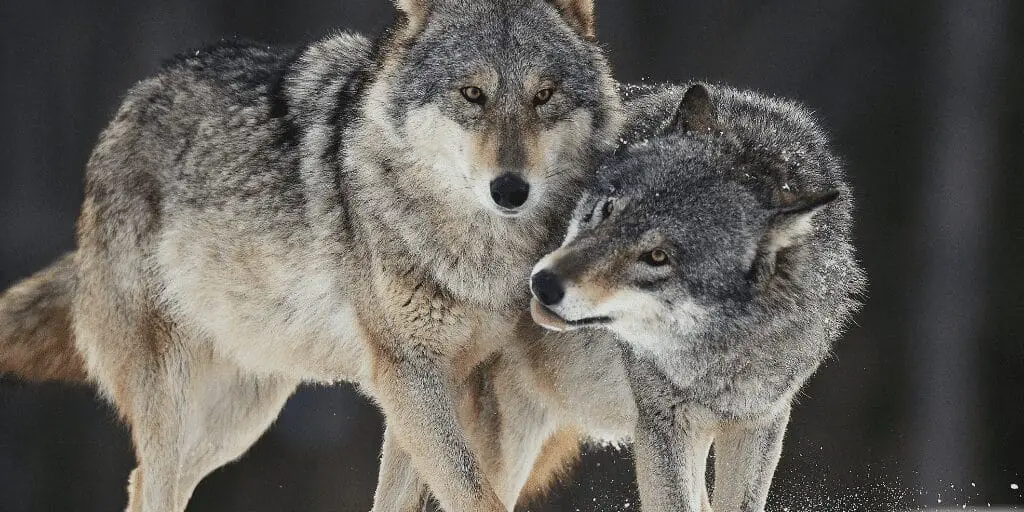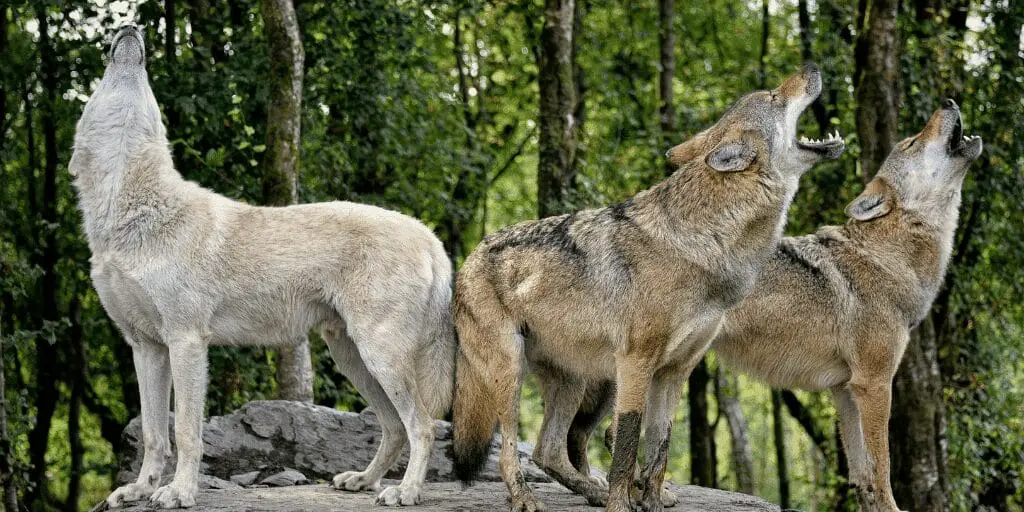Discover the truth behind a captivating wildlife enigma: do wolves purr? Uncover the reality of wolf vocalizations and the intricate ways these majestic creatures communicate. This article delves into the science, dispelling myths and revealing the rich emotional tapestry of wolf packs.
Key Takeaways:
- Wolves do not purr; this is a myth likely stemming from anthropomorphic storytelling and cultural representations that attribute feline characteristics to wolves.
- Wolf vocalizations are complex and serve various purposes, including territory marking, pack rallying, and social bonding, but purring is not part of their vocal repertoire due to anatomical differences from cats.
- Wolves communicate using a sophisticated system of vocal and non-vocal cues, including howls with specific dialects, body language, and scent marking, which are essential for their survival and social structure.
- Expressions of joy and affection in wolves include playful behaviors like the “play bow,” light barks, and yips, as well as more subtle signs of contentment such as soft whines or relaxed postures.
- Misconceptions about wolves, such as the ability to purr, can impact wolf conservation efforts by influencing public perception and policy; accurate information and education are crucial for their protection and understanding of their ecological role.
The Truth About Wolf Vocalizations and the Myth of Purring
Wolves do not purr; they lack the specific anatomy and neural mechanisms that enable cats to produce a purring sound.
| Aspect | Details |
| Wolf Purring Myth | Wolves do not purr. This myth likely originates from anthropomorphic storytelling and cultural representations, attributing feline characteristics to wolves. |
| Wolf Vocalizations | Wolf vocalizations are complex, serving purposes like territory marking, pack rallying, and social bonding. They include howls, barks, growls, and whines, but not purring, due to anatomical differences from cats. |
| Communication Methods | Wolves use a sophisticated system of vocal and non-vocal cues for communication, including body language and scent marking. Expressions of joy and affection involve playful behaviors, light barks, yips, soft whines, and relaxed postures. |
| Misconceptions and Conservation | Misconceptions, such as wolves being able to purr, can impact conservation efforts by shaping public perception and policy. Accurate information and education are vital for wolf protection and understanding their ecological role. |
| Scientific Insights | Wolves have a rich vocal repertoire but lack the specific anatomy (neural oscillator) for purring, unlike cats. Their vocalizations are facilitated by their larynx and controlled by the brain, playing a crucial role in their social structure and survival strategies. |
| Evolutionary Perspectives | Wolf vocalizations have evolved to meet survival needs, such as coordinating hunts and establishing territories. Comparative studies with other canids highlight the evolutionary adaptations that have shaped wolf communication. |
| Cultural Influence on Wolf Myths | Cultural stories and media often anthropomorphize wolves or attribute them with characteristics of other animals, contributing to misconceptions like the ability to purr. These portrayals can distort public understanding of wolf behavior. |
| Impact of Misconceptions | Misconceptions about wolf behavior, including purring, can lead to fear, mistrust, and policy implications that negatively affect wolf conservation. Education and dissemination of accurate information are crucial for correcting myths and supporting conservation efforts. |
Do Wolves Purr?

Exploring the Myth of Purring Wolves
The image of a purring wolf may stem from tales where animals speak and act like humans, or from movies that paint wolves as mystical creatures with a range of emotional expressions akin to our domesticated pets.
Think of stories where wolves are guardians of ancient secrets or noble companions to heroes, often depicted with a softer side that could suggest a purr-like sound.
However, these are creative liberties, blending the lines between fantasy and the true nature of wolves. The idea that wolves purr is a charming notion, but it’s one born from the imagination rather than reality.
Scientific Insights into Wolf Vocalizations
Diving into the science, wolves have a vocal repertoire that is both rich and complex, but it does not include purring. The anatomy of a wolf’s throat and the muscles around the voice box are significantly different from those of a cat.
Cats purr using a unique neural oscillator in their brain, which wolves lack. Studies have shown that wolves communicate through howls, whines, barks, and growls, each with distinct meanings and purposes.
Researchers using spectrographic analysis can map out these sounds, confirming that the gentle rumble of a purr is absent from the wolf’s vocal toolkit.
The Purpose of Vocalizations in Wolves
Wolves use their voices to survive and thrive in the wild. A howl can travel miles, announcing territory or rallying the pack together. Growls and snarls serve as warnings, signaling aggression or defense.
Whines and yips may reinforce social bonds or express submission. Each sound is a thread in the complex social fabric of a wolf pack, demonstrating that their communication is as sophisticated as it is essential. By understanding the context and purpose of these vocalizations, we gain insight into the intricate social lives of these majestic animals.
Understanding Wolf Communication
Wolves are often thought of as mysterious creatures of the wild, their haunting howls echoing through the forests and tundras they inhabit. But their communication is far more complex than a simple chorus to the moon.
It’s a sophisticated system that includes a variety of vocalizations, body language, scent marking, and other non-verbal cues. Wolves interact with one another in a rich tapestry of signals, conveying complex messages that are essential for their survival and social structure.
The Language of Howls: Decoding Wolf Howls
The howl of a wolf is not just a call into the void; it’s a multifaceted language with specific dialects for different situations. Lone howls can be a cry for companionship or a declaration of existence, while rally howls serve as a pack’s roll call or a prelude to hunting.
Alarm howls are urgent, broadcasting danger or warding off intruders. Each howl has its own acoustic signature, allowing wolves to identify individuals over great distances, which is crucial for maintaining territorial boundaries and pack cohesion.
Beyond Howling: Other Vocal Sounds
Wolves have a vocal repertoire that extends well beyond the iconic howl. Barks can signal alarm or serve as a warning. Growls may express dominance or aggression. Whines and yips often occur in social interactions, reflecting everything from submission to affection.
These sounds are the threads of a complex emotional tapestry, revealing that wolves are not just creatures of the night, but beings with a deep capacity for expression.
Non-Vocal Communication Methods
Wolves communicate volumes without ever making a sound. A lowered tail can indicate submission, while an erect tail might demonstrate confidence or dominance. Ears pinned back against the head could be a sign of aggression or fear, and facial expressions can be surprisingly expressive.
Scent marking is another critical component, leaving chemical messages that delineate territories and convey individual identity. Together with vocalizations, these non-vocal methods create a rich, layered language that is as intricate as any human society’s.
How Wolves Express Joy and Affection

Contrary to the fierce and solitary image often associated with wolves, this section will reveal the rich emotional life of wolves, focusing on how they express positive emotions like joy and affection. It will cover the sounds and behaviors wolves display during playful interactions, social bonding, and familial connections.
Playful Vocalizations and Behaviors
When wolves are in high spirits, they have a unique way of showing it. You might hear a series of light barks or yips, which are often an invitation to play. One of the most endearing sights is the “play bow” – front legs stretched forward, rear end up, and tail wagging.
This posture is not just adorable; it’s a critical part of how wolves strengthen their social bonds. Through these playful exchanges, wolves also teach their young the nuances of pack life, ensuring that the group remains united and effective.
Affectionate Interactions Among Pack Members
Wolves might have a reputation for being tough, but they also have a softer side. They express affection within their pack through behaviors that might remind you of domestic dogs. Nuzzling, licking, and even gentle nibbling between pack members are common sights.
These actions are far from just cute; they’re vital for maintaining the intricate web of relationships that keep the pack functioning smoothly. Strong familial ties are the backbone of a wolf pack, and these affectionate interactions are the glue that holds them together.
Vocal and Non-Vocal Expressions of Contentment
Beyond the more obvious displays of joy, wolves also have subtler ways of expressing their contentment. Soft whines or sighs might be heard, indicating a wolf is at ease.
Their body language speaks volumes too – a relaxed posture, a calm gaze, and a gentle tail wag can all signal that a wolf is feeling happy and content.
These expressions are more than just signs of a good mood; they’re essential for the emotional health of the pack. Understanding these quieter moments of happiness gives us a glimpse into the complex social dynamics and emotional intelligence that wolves possess.
The Science Behind Wolf Vocalizations
Anatomy of Wolf Vocalizations
When wolves communicate, it’s a whole-body affair, starting with their impressive vocal anatomy. Deep within the throat, the larynx houses the vocal cords, which are the starting point for the haunting howls and sharp barks we associate with these wild canines.
Unlike the gentle purring of a cat, which arises from a rapid twitching of the laryngeal muscles, wolves use their vocal cords to produce a wider range of sounds.
Air from the lungs rushes past these cords, and as they vibrate, sound is born. The shape and size of the wolf’s larynx and the strength of the respiratory system all contribute to the depth and power of their vocalizations. It’s a setup that’s quite different from the feline purr machinery, tailored to a life of long-distance communication and complex social interactions.
The Role of the Brain in Producing Vocal Sounds
The wolf’s brain is the maestro of this vocal orchestra, conducting every howl, growl, and whimper. It’s here that the decision to vocalize is made, a process that involves a symphony of neurological activity.
The brain sends precise signals to the muscles controlling the vocal cords, adjusting tension and breath to create just the right sound. But it’s not all mechanics; wolves also express a rich tapestry of emotions through their calls.
Recent studies have begun to unravel how different brain regions are activated during these vocal expressions, suggesting that wolves, much like us, use their voices to convey feelings and intentions to their pack members.
Evolutionary Perspectives on Wolf Vocalizations
Vocalizations are more than just noise; they’re a key to survival in the wild. Over countless generations, wolves have honed their calls to perfection, using them to coordinate complex hunts and to establish territories.
These vocal behaviors are deeply embedded in the social fabric of the pack, reinforcing bonds and hierarchies. Comparative studies with other canids, including the domestic dog, reveal a fascinating evolutionary journey.
The nuanced differences and similarities in their calls offer clues to the selective pressures that have sculpted wolf vocalizations over time. It’s a rich history written in the language of howls and growls, echoing through the forests and across the evolutionary landscape.
Misconceptions About Wolves and Purring

Debunking the Purring Myth
When it comes to understanding wolves, it’s easy to get tangled in a web of myths. One such myth is that wolves can purr, similar to what we hear from our feline friends. However, this couldn’t be further from the truth.
Wolves do not have the anatomy that enables cats to purr. Cats purr using their laryngeal muscles, but wolves use their vocal cords to produce sounds such as howls, barks, and whines. These vocalizations serve as communication tools within packs and are a key part of their social structure.
Misconceptions like these often stem from a lack of knowledge or from anthropomorphizing animals, attributing them with human or in this case, feline characteristics. It’s crucial to lean on scientific findings to peel away the layers of fiction and understand the real behavior of wolves.
Cultural Influences on Wolf Myths
Wolves have been a part of human storytelling for centuries, often depicted with attributes borrowed from other animals or even humans. From the ‘Big Bad Wolf’ in fairy tales to the noble direwolves in fantasy series, these portrayals have left a lasting impression on how we view wolves.
Such stories can blur the lines between reality and fiction, leading some to believe that wolves share traits with other creatures, such as the ability to purr. While these cultural representations can be entertaining, they also contribute to a skewed perception of wolf behavior, which can be hard to correct without a concerted effort to disseminate accurate information.
The Impact of Misconceptions on Wolf Conservation
The way wolves are perceived can have a direct impact on their survival. Myths and misunderstandings can lead to fear or mistrust, which in turn can influence policies and attitudes towards wolf conservation.
For instance, if wolves are seen as mystical creatures with almost supernatural abilities, it might hinder the public’s understanding of their role in the ecosystem. On the flip side, viewing them as villainous can lead to unwarranted culling. Education plays a pivotal role in conservation efforts.
By dispelling myths and spreading factual information about wolves, we can foster a more informed and compassionate approach to their preservation, ensuring that these majestic animals continue to thrive in their natural habitats.
Conclusion
The notion that wolves can purr is a myth rooted in cultural storytelling and anthropomorphism, not in scientific fact. Wolves possess a complex and sophisticated system of vocalizations, including howls, barks, whines, and growls, each serving specific communicative functions within their social structure.
Their vocal anatomy and brain function are uniquely adapted for these sounds, which are essential for expressing emotions, reinforcing social bonds, and ensuring survival.
While wolves do exhibit behaviors that convey joy and affection, such as playful barks and affectionate nuzzling, these are not akin to the purring of cats, which is produced by a completely different anatomical mechanism.
Understanding the true nature of wolf communication is crucial for dispelling misconceptions and promoting effective conservation efforts. By appreciating the rich emotional and social lives of wolves, we can better appreciate their role in the ecosystem and the importance of their preservation.
- What Should I Do If A Koala Bites Me? Safety Guide - 2024-05-30
- Are Kangaroos Born Without Hind Legs? A Fascinating Journey - 2024-05-30
- Animals That Look Like Squirrels - 2024-05-30








